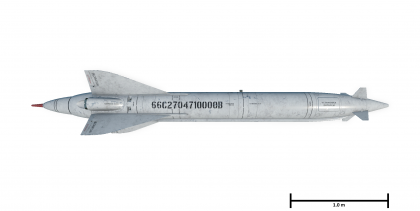Difference between revisions of "Kh-66"
miguelturner (talk | contribs) (→Comparison with analogues) (Tag: Visual edit) |
miguelturner (talk | contribs) (→See also) (Tag: Visual edit) |
||
| Line 67: | Line 67: | ||
== See also == | == See also == | ||
| − | '' | + | '''''Related development''''' |
| + | |||
| + | * [[Kh-29T]] | ||
| + | * [[Kh-29L]] | ||
| + | * [[Kh-25ML]] | ||
| + | * [[Kh-23M]] | ||
| + | |||
| + | '''''Weapons of comparable role, configuration, and era''''' | ||
| + | |||
| + | * [[AGM-12B Bullpup|AGM-12B]] | ||
| + | * [[AGM-12C Bullpup|AGM-12C]] | ||
| + | * [[AS-20 Nord]] | ||
| + | * [[AS-30 Nord]] | ||
| + | * [[AS-30L Nord]] | ||
| + | * [[Rb05A]] | ||
| + | * [[RB 75]] | ||
| + | |||
| − | |||
| − | |||
== External links == | == External links == | ||
Revision as of 05:26, 26 August 2022
Contents
Description
The Kh-66 is a Soviet SACLOS-guided air-to-ground missile. It was introduced during Update "Hot Tracks".
Vehicles equipped with this weapon
General info
| Missile characteristics | |
|---|---|
| Mass | 278 kg |
| Guidance | Semi-automatic (SACLOS) |
| Maximum speed | 2 M |
| Missile guidance time | 25 secs |
| Firing range | 10 km |
| Explosive mass | 65.28 kg TNTeq |
| Armour penetration | 74 mm |
Effective damage
A direct hit is almost always guaranteed to cripple if not outright destroy an enemy tank. It is also able to destroy lightly and even medium-armoured targets with proximity impact.
Comparison with analogues
While the Kh-66 is a decent choice for players compared to the less effective S-5K missiles available to them. It lags behind other nations such as the US and Italy as the AGM-12 has an extra 2 km range over the Kh-66. Another downside is that the aircraft can only carry two missiles compared to the Italian G.91 R/4 and US A-4B/E which can carry 4 missiles each (five in the case of the A-4E). One positive note may be that mouse-aimed missiles are easier to steer to the target than the ones using WASD keys. Alternatively, they inflict more damage than other air-to-ground missiles thanks to the Kh-66's superior explosive mass, leading to better outcomes against lightly-armoured targets.
Usage in battles
The Kh-66 is used to perform Close Air Support from outside enemy AA effective range.
Pros and cons
Summarise and briefly evaluate the weaponry in terms of its characteristics and combat effectiveness. Mark pros and cons as a list.
Pros:
- Great range, greater than most AA missiles
- High explosive mass
Cons:
- Hard to aim
- Only two missiles
- Heavy weight impacts flight performance
History
The Kh-66 is an early version of the Kh-23 Grom air-to-ground missile. The missile was developed from the existing K-5 and K-8 (RS-2-US) beam-riding air-to-air missiles. Just before the war in Vietnam, the United States began fielding new guided missiles; most notably the AGM-12 Bullpup, which caused the Soviet Ministry of Aircraft Industry to request an air-to-ground version of earlier RS-2-US beam riding air-to-air missile.[1]
This new missile was designated Kh-66 (as the year it entered design/testing was 1966) and began to be used on the MiG-21PFM airframe (itself a testbed aircraft designed in conjunction with the Kh-66). Later in 1968, the missile finally entered service. The weapon was an amalgamation of the K-5 and K-8's guidance and propulsion systems and had an increased warhead for better performance against ground and sea-based targets. While the missile performed at the required specifications set by the Soviet government, the weapon was only a stopgap measure until more suitable armaments were developed. This was due to the flaws in utilizing the weapon as the pilot had to dive towards his target and maintain a lock with the gunsight. The missile was further developed into the Kh-23 by Korolyov again in early 1968 with the intention of making the weapon more effective. With this, the Kh-66 was effectively put out of production for new models by 1973.[2]
Media
Excellent additions to the article would be video guides, screenshots from the game, and photos.
See also
Related development
Weapons of comparable role, configuration, and era
External links
References
- ↑ Friedman, Norman (1997), The Naval Institute Guide to World Naval Weapons Systems, Naval Institute Press, p. 235, ISBN 978-1-55750-268-1
- ↑ https://web.archive.org/web/20110727014325/http://eng.ktrv.ru/docs/history_eng.doc History of JSC Tactical Missile Corporation, pp. 3–4, archived from http://eng.ktrv.ru/docs/history_eng.doc (Word 97 DOC) on 2011-07-27, retrieved 2009-02-15




